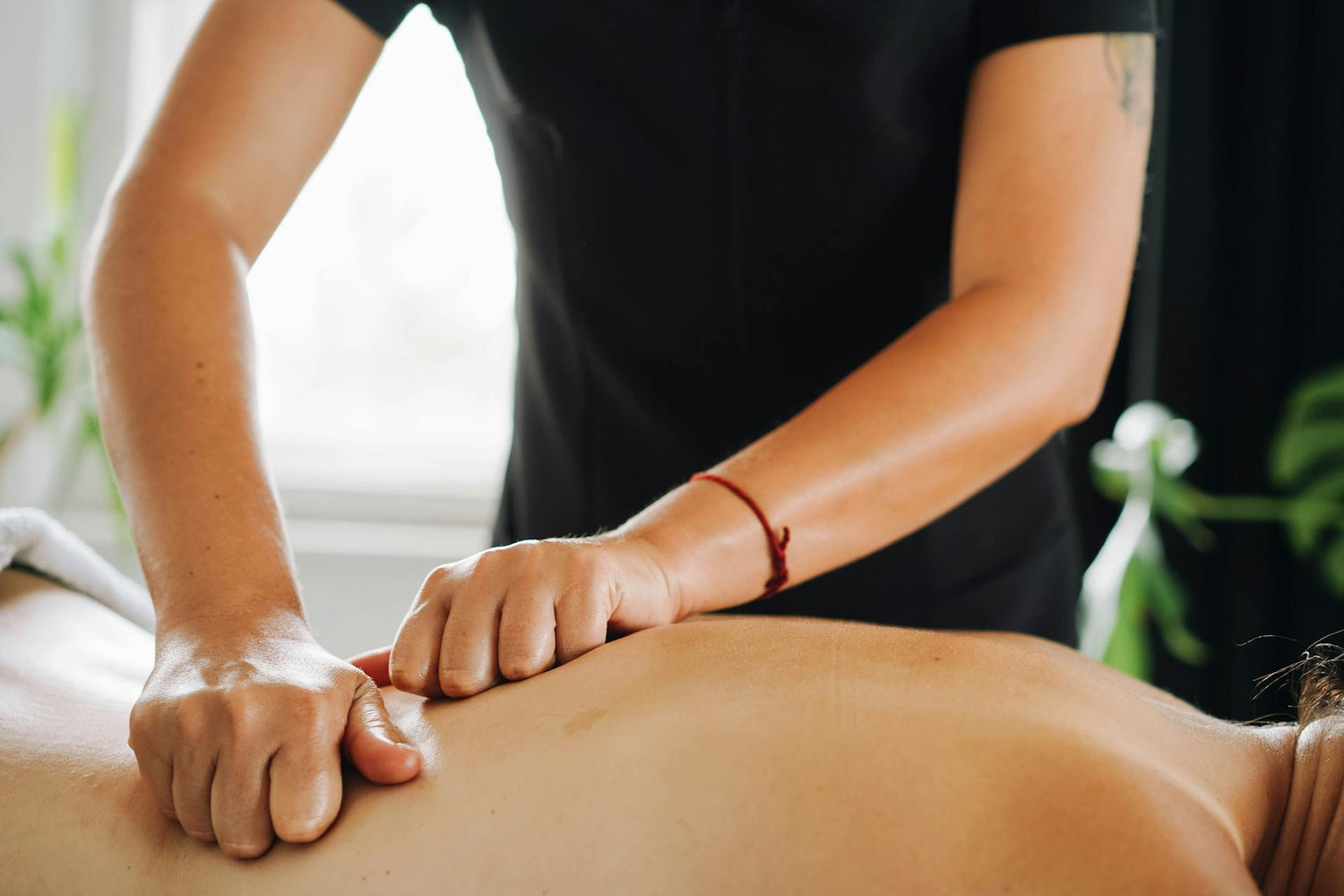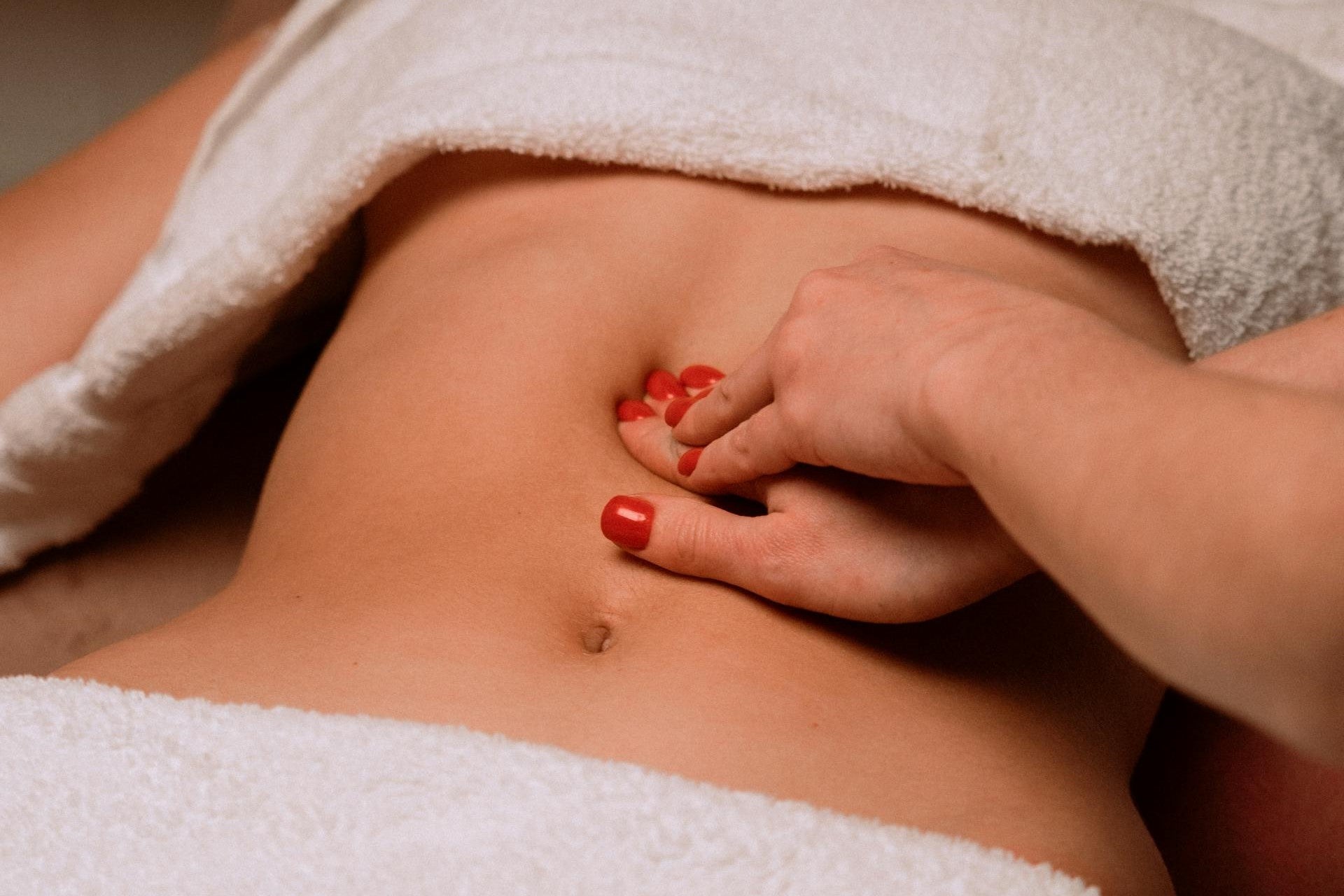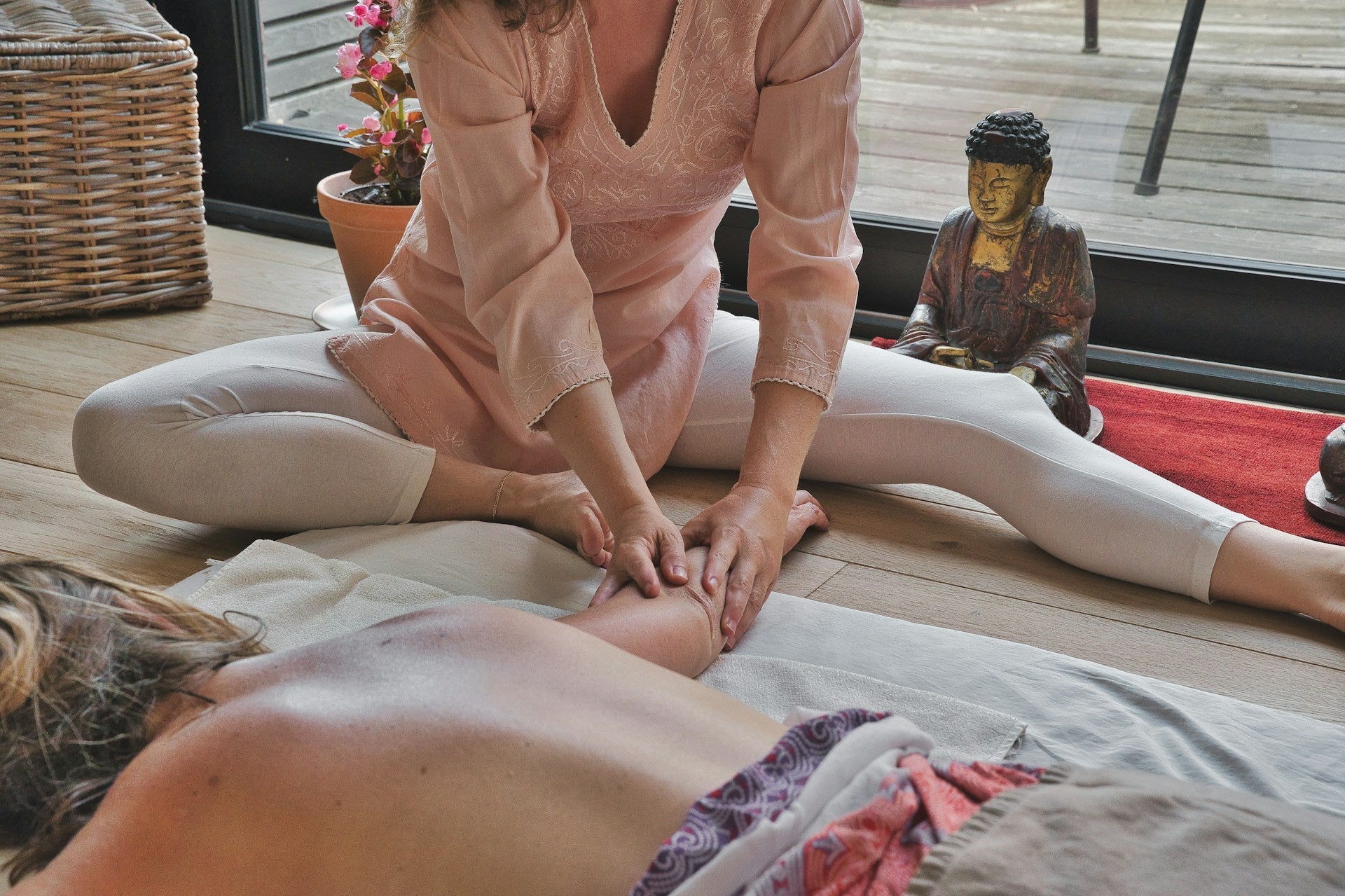Vous souffrez de ballonnements, de douleurs et d'inconfort liés à la constipation ? Vous n'êtes certainement pas seul. Jusqu'à 16 % des adultes présentent des symptômes de constipation, et chez les personnes de plus de 60 ans, ce chiffre grimpe à 33 %. Que le coupable soit un régime pauvre en fibres, une nouvelle prescription ou simplement le fait de ne pas boire suffisamment d'eau pendant la journée, la bonne nouvelle est que le massage peut vous aider à faire bouger les choses.
Les recherches suggèrent que le massage peut aider à stimuler la digestion à court et à long terme, et le meilleur dans tout cela, c'est qu'il est facile à essayer à la maison. Lisez la suite pour en savoir plus sur les bienfaits du massage contre la constipation, ainsi que sur les réponses aux questions courantes et sur quatre auto-massages simples à essayer.
Quelles sont les causes de la constipation ?
De nombreux facteurs peuvent jouer un rôle dans le ralentissement de la digestion, et il n'est pas toujours possible de tous les contrôler. Mais à l'ère moderne, le régime alimentaire américain standard (qui tend à être hautement transformé et pauvre en liquides et en fibres) peut être un facteur majeur.
Les fibres sont un type de glucides bénéfiques pour l'intestin qui facilitent la digestion. On en trouve en abondance dans les fruits, les légumes et les céréales complètes, mais on en trouve peu (ou pas du tout) dans les viandes, les produits laitiers ou les aliments hautement transformés. De plus, le manque d'exercice dans la vie moderne peut également contribuer à ralentir la digestion et à provoquer des symptômes de constipation.
L'alimentation et le mode de vie peuvent contribuer à la constipation, mais ils ne sont certainement pas les seules causes. D'autres raisons peuvent expliquer une digestion lente :
- Des ordonnances, comme des analgésiques à base d’opiacés et certains médicaments contre l’hypertension
- Ne pas avoir l’impression d’avoir suffisamment d’intimité pour utiliser les toilettes
- Niveaux élevés de stress, d'anxiété ou de dépression
- Un changement récent dans votre mode de vie, comme commencer un nouvel emploi, déménager dans un nouvel endroit ou changer de régime alimentaire
- Affections médicales affectant le tube digestif, les hormones ou d’autres organes
- Grossesse
Comment le massage aide-t-il à lutter contre la constipation ?
Lorsque vous vous sentez constipé, votre premier réflexe peut être de boire un verre d'eau, de prendre un laxatif ou simplement d'attendre. Mais si vous cherchez un autre remède, la massothérapie peut être une bonne idée. Elle peut aider à combattre la constipation en :
Stimuler le système digestif
Un bon massage peut stimuler le système digestif et favoriser la circulation sanguine abdominale, ce qui peut aider votre système à se mettre en mouvement. De plus, un massage suivant le mouvement naturel de vos intestins et de votre côlon peut favoriser des contractions musculaires ondulatoires appelées péristaltisme . Ces contractions font partie intégrante du processus digestif et aident vos intestins à faire avancer les déchets.
Détendre le corps
Le massage peut également aider votre corps à passer en mode « repos et digestion » en activant votre système nerveux parasympathique, ce qui peut aider à lutter contre la constipation de plusieurs manières essentielles.
Les hormones du stress comme le cortisol peuvent provoquer une tension musculaire, ce qui peut aggraver les symptômes de la constipation. En outre, les émotions stressantes peuvent également être perçues dans les intestins par le biais de certains neurotransmetteurs. Ainsi, en vous faisant un massage apaisant , vous pouvez signaler à vos intestins qu'il est temps de vous détendre, ce qui, en retour, aidera votre système digestif à se remettre sur les rails.
Existe-t-il des recherches sur le massage contre la constipation ?
Le massage est utilisé depuis des décennies pour soulager la constipation, et des recherches récentes suggèrent qu’il peut apporter de réels bienfaits.
Une étude de quatre semaines réalisée en 2022 a cherché à savoir si le massage abdominal pouvait aider à lutter contre la constipation chronique fonctionnelle. Les chercheurs ont recruté 74 participants et les ont répartis en deux groupes :
- Le premier groupe a reçu un massage et des conseils sur le mode de vie
- Le deuxième groupe a reçu une thérapie par ultrasons ainsi que des conseils sur le mode de vie
Les deux groupes ont ressenti des bienfaits à la fin de l’étude, mais ceux du groupe de massage ont connu les changements les plus significatifs dans leurs symptômes.
De plus, une méta-analyse de 2023 a révélé que le massage peut aider à lutter contre la constipation en augmentant la fréquence d’utilisation des toilettes, en facilitant l’évacuation des selles et en améliorant la qualité de vie globale.
Avant de commencer
Pour la plupart des gens, essayer le massage contre la constipation est généralement sans danger, mais il est important de noter que cela ne convient pas à tout le monde. Par exemple, les personnes souffrant de certains problèmes de santé doivent toujours consulter leur médecin avant d'essayer le massage, car une pression exercée au mauvais endroit peut provoquer ou aggraver les symptômes.
Cela dit, assurez-vous de vérifier d’abord auprès de votre équipe soignante si vous êtes enceinte ou si vous avez :
- Maladie inflammatoire chronique de l'intestin (MICI), car la pression abdominale peut aggraver l'inconfort ou l'irritation chez certaines personnes
- Tout problème de santé affectant le côlon ou le tube digestif
- Cancer
- Une blessure instable à la colonne vertébrale
- Une blessure à l'estomac ou une convalescence après une quelconque forme de chirurgie abdominale
Il est également important de garder à l'esprit que certaines thérapies et certains médicaments peuvent avoir un impact sur la réponse de votre corps au massage. Veillez donc à demander l'avis d'un professionnel de la santé à l'avance si vous prenez des médicaments sur ordonnance ou si vous recevez des traitements.
Comment essayer le massage contre la constipation : 4 méthodes

Une fois que vous avez obtenu le feu vert pour essayer le massage contre la constipation, voici quatre techniques simples pour détendre votre intestin et aider à stimuler votre digestion :
Technique de massage ILU
La technique de massage ILU est l'une des options pratiques les plus simples pour soulager la constipation, les crampes et le confort abdominal. L'objectif de ce massage est de suivre la direction naturelle de votre gros intestin afin de favoriser une motilité intestinale saine.
Vous pouvez l'essayer en étant assis, allongé ou même debout sous la douche. Vous pouvez également le faire par-dessus vos vêtements ou directement sur la peau à l'aide d'une lotion ou d'un savon. Pour l'essayer :
- Commencez par la lettre « I ». Commencez par utiliser une ou deux mains pour appuyer doucement et glisser vers le bas sous votre cage thoracique gauche en direction de votre os de la hanche gauche. Répétez 8 à 10 fois.
- Ensuite, il est temps de faire la lettre « L ». Appuyez doucement sous votre cage thoracique droite, glissez vers la gauche et balayez vers le bas jusqu'à l'os de la hanche gauche. Répétez encore 8 à 10 fois.
- Enfin, vous masserez en faisant un mouvement en « U ». Commencez par appliquer une légère pression juste au-dessus de l'os de la hanche droite. Ensuite, faites glisser vers le haut en direction des côtes droites. Arrêtez-vous juste en dessous des côtes droites et balayez vers le côté gauche de votre abdomen. Enfin, faites glisser vers le bas en direction de l'os de la hanche gauche pour terminer la forme en « U ». Répétez encore 8 à 10 fois.
Massage abdominal circulaire simple
Bien que l’ILU soit une méthode simple à essayer pour soulager la constipation, un simple massage circulaire du côlon peut également être utile.
Pour cette méthode, allongez-vous ou asseyez-vous, respirez profondément et laissez votre ventre se détendre. Ensuite, utilisez une main et une légère pression pour masser votre abdomen en mouvements apaisants dans le sens des aiguilles d'une montre. Pour stimuler l'intestin grêle, vous pouvez utiliser des mouvements circulaires plus petits et plus ciblés sur la zone juste autour du nombril.
Essayez un masseur corporel thérapeutique
Lorsque vous pensez aux outils de massage, vous pensez peut-être aux pistolets de massage ou aux masseurs de pieds, mais ce ne sont pas les seules options disponibles. Pour un massage à domicile qui peut aider à lutter contre la constipation et à soulager tout le corps, le MedMassager Body Massager Plus est un outil doux mais puissant à essayer.
Il utilise des mouvements oscillants réparateurs et est conçu pour être convivial, que vous préfériez l'utiliser à la main ou de manière stationnaire pour un massage passif et relaxant.
Si vous avez des problèmes de santé, n'hésitez pas à consulter votre médecin avant de commencer. Avec son feu vert, voici comment vous pouvez l'essayer contre la constipation :
- Démarrez votre MedMassager à son réglage de pression le plus léger.
- Alignez-le avec la partie inférieure droite de votre ventre et faites-le tourner doucement dans le sens des aiguilles d'une montre pendant 3 à 5 minutes ( Conseil : gardez à l'esprit la forme en « U » de la méthode ILU pour vous assurer de suivre le flux naturel de votre tube digestif.)
- En option, vous pouvez le positionner derrière vous et vous pencher en arrière pour un massage du dos supplémentaire de 10 minutes.
Réflexologie des mains et des pieds ou acupression
Bien que moins étudiés que le massage du ventre pour la digestion, le massage des mains et des pieds sont tous deux des choix populaires pour soulager la constipation.
De nombreuses personnes apprécient particulièrement la réflexologie des mains et des pieds, un type de massage ancien qui cible les points de pression censés être reliés à d’autres parties du corps. L’idée est qu’en stimulant des points liés au foie, aux intestins ou à d’autres organes, cela pourrait aider à ralentir ou à bloquer la digestion.
Bien qu'il n'existe pas encore beaucoup d'études sur la réflexologie et la digestion, les premiers résultats sont prometteurs jusqu'à présent. Par exemple, une revue de 2020 portant sur sept petites études a révélé que la réflexologie pouvait soulager certains symptômes liés à la constipation. Et à tout le moins, si vous êtes quelqu'un qui aime un bon massage des mains ou des pieds, cela peut être un excellent moyen de mettre votre corps en mode repos et digestion.
Sur quels points devez-vous vous concentrer ?
Le point L3, situé à quelques centimètres de profondeur dans l'espace entre le gros et le majeur des orteils, est un point de pression qui, selon beaucoup, favorise la digestion. Un autre point à essayer est le point LI4 , ou le point de la vallée de la main, qui se trouve dans la sangle entre le pouce et l'index.
Conseils pour obtenir le plus de soulagement
Avant d’essayer l’auto-massage contre la constipation, voici quelques conseils pour vous aider à rester à l’aise tout en obtenant le plus de soulagement possible :
- Utilisez le massage lorsque vous êtes détendu , par exemple lorsque vous êtes au lit ou que vous prenez un bain chaud.
- Faites attention à la réponse de votre corps et assurez-vous d’éviter toute technique qui semble aggraver votre inconfort.
- Combinez-le avec d'autres remèdes . Des mouvements doux, des étirements ou des exercices légers peuvent également fonctionner de concert avec le massage pour aider à stimuler votre digestion.
- Essayez de ne pas vous masser juste après avoir mangé. Il est préférable d'attendre au moins 1 à 2 heures après les repas pour donner à votre corps le temps de digérer certains aliments.
Questions fréquemment posées sur le massage contre la constipation
Voici quelques-unes des questions les plus courantes concernant le massage pour la constipation et une meilleure digestion :
- Quel type de massage est le plus adapté à la constipation ? En général, le massage « ILU » est l’une des meilleures techniques pour stimuler la digestion. De nombreuses personnes trouvent qu’il fonctionne bien car il suit le flux naturel du tube digestif, tout en favorisant les contractions musculaires pour faciliter le mouvement des aliments.
- Dans quelle direction masser votre ventre en cas de constipation ? Pour un massage simple du ventre, pensez toujours à masser dans le sens des aiguilles d'une montre. Commencez par le bas du côté droit de votre ventre, remontez vers vos côtes droites, puis vers la gauche et enfin vers l'os de la hanche gauche. En cas de doute, rappelez-vous simplement que vous devez masser vers le bas sur le côté gauche, car c'est là que se trouve votre côlon descendant.
- Combien de temps faut-il pour qu’un massage commence à faire effet ? Un massage rapide peut apporter un soulagement en seulement 15 à 30 minutes. Mais les recherches montrent qu’un massage régulier peut également aider à lutter contre la constipation à long terme.
Autres conseils et remèdes maison pour soulager la constipation
Le massage peut être utile lorsque vous souhaitez stimuler rapidement votre digestion. Mais il existe de nombreux autres conseils fiables qui peuvent vous aider à favoriser une digestion plus saine, à la fois rapidement et sur le long terme.
Des changements de style de vie à grande échelle aux remèdes rapides, voici quelques mesures que vous pouvez prendre pour réduire les symptômes de la constipation :
Restez hydraté
La déshydratation est une cause majeure (et parfois négligée) de constipation. Lorsque votre organisme ne contient pas assez d'eau, les selles peuvent être plus dures et, par conséquent, plus difficiles à évacuer par le côlon. Ainsi, si vous souffrez souvent de constipation, vous constaterez peut-être une grande différence en augmentant votre consommation d'eau.
Ajustez votre régime alimentaire
En plus de rester hydraté, ce que vous mangez joue également un rôle majeur dans votre santé digestive. Un régime alimentaire riche en viandes, farines et huiles ultra-transformées peut également être pauvre en fibres et en hydratation, ce qui peut aggraver les problèmes de digestion.
Heureusement, ajouter plus de fibres à votre alimentation peut être relativement simple — et en prime, les aliments riches en fibres sont souvent également riches en eau.
Parmi les aliments riches en fibres et en eau, vous pouvez essayer des fruits comme les framboises, les poires et les pommes, ainsi que des légumes comme le brocoli, le chou et les légumes à feuilles vertes. De plus, les noix, les graines, les légumineuses et les céréales complètes peuvent également contribuer à augmenter votre apport en fibres.
Essayez le café contenant de la caféine
La caféine, et le café en particulier, peuvent être un outil étonnamment puissant pour favoriser le transit intestinal. Comment cela fonctionne-t-il ? En bref, une tasse de café peut amener votre corps à libérer une hormone appelée gastrine, qui peut déclencher le réflexe gastrocolique . Ce réflexe peut accélérer la digestion en aidant votre côlon à se contracter.
Faites de l'exercice régulièrement
Avez-vous remarqué que votre constipation s’aggrave lorsque vous ne bougez pas beaucoup ? Vous n’êtes pas seul. Rester actif est essentiel pour garder vos muscles abdominaux forts et cela joue également un rôle dans la stimulation de la digestion. « Fondamentalement », comme le dit un article de Harvard Health de 2023 , « le côlon réagit à l’activité ». De plus, l’exercice régulier peut aider à soulager le stress qui peut rendre plus difficile l’aller aux toilettes.
Mettre en place une routine d’exercice peut sembler intimidant, mais il peut être étonnamment facile de commencer. Une marche rapide autour du pâté de maisons, une séance de yoga rapide ou une séance d’entraînement au poids du corps de 10 minutes sont toutes de bonnes façons de bouger. Quel que soit votre choix, intégrer un peu plus de mouvement dans votre vie quotidienne pourrait vous aider à constater un changement positif dans votre digestion.
Utilisez des laxatifs pour aider à ramollir les selles
Pour certaines personnes souffrant de constipation, les laxatifs peuvent être une bonne solution temporaire. Les principaux types de laxatifs disponibles fonctionnent généralement en effectuant une ou plusieurs des actions suivantes :
- Stimuler les muscles du tube digestif
- Augmentation du volume des selles
- Selles ramollies
- Attirer plus d’eau dans les intestins
Il est important de noter que les laxatifs peuvent ne pas convenir à certaines personnes souffrant de certains problèmes de santé et qu'ils ne sont généralement pas recommandés pour les enfants. Par conséquent, si vous avez des questions, assurez-vous d'obtenir l'accord de votre médecin avant de les essayer.
Quand consulter un médecin en cas de constipation
La constipation due à un changement de mode de vie, à un stress récent ou à des habitudes alimentaires disparaît souvent d'elle-même à l'aide de remèdes maison. Mais dans certains cas, la constipation peut être liée à un problème de santé plus grave. Consultez votre médecin si vous avez :
- Douleur intense au ventre ou à l'abdomen
- Perte de poids involontaire
- Présence de sang ou autres changements préoccupants dans les selles
- Constipation soudaine après n’en avoir jamais souffert auparavant
L'essentiel
Du stress à un nouvel emploi en passant par le manque d'eau, tous ces facteurs peuvent être à l'origine de troubles digestifs. La constipation peut être compliquée. Heureusement, l'auto-massage est un remède maison simple qui pourrait aider votre organisme à se remettre sur les rails.
Les meilleures techniques, comme la méthode ILU ou le massage abdominal dans le sens des aiguilles d’une montre, sont incroyablement simples et faciles à essayer. Mais si vous souhaitez bénéficier d’un massage à long terme tout en aidant votre corps à se mettre en mode « repos et digestion » plus souvent, un appareil de massage corporel thérapeutique à domicile pourrait vous aider.
Découvrez le masseur corporel MedMassager Plus dès aujourd’hui pour commencer ou apprenez-en plus sur les nombreuses façons apaisantes de l’utiliser.



